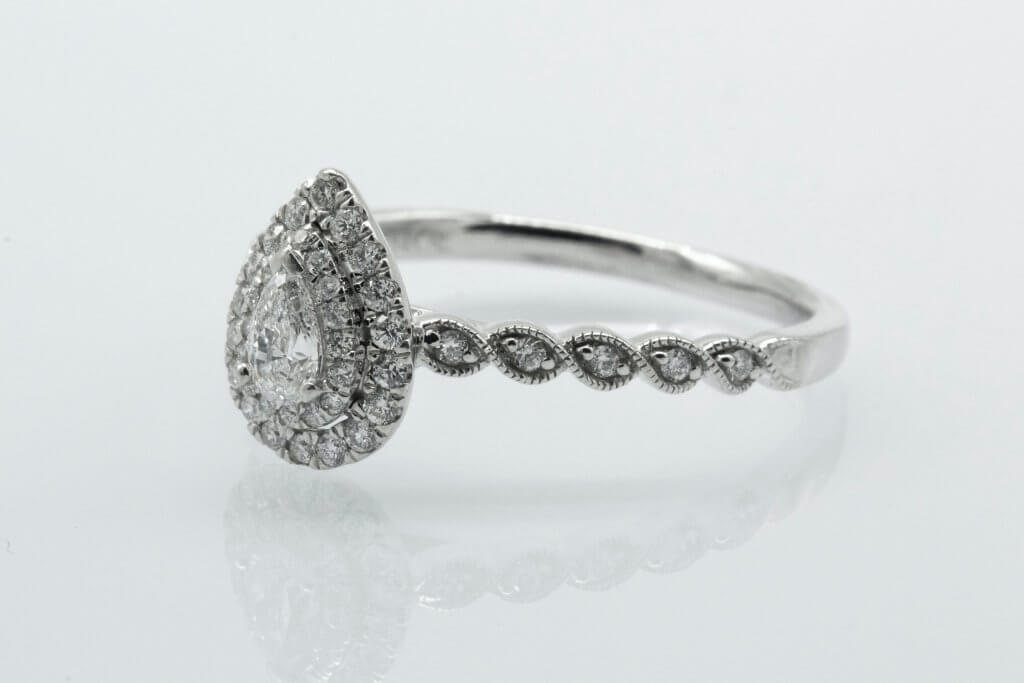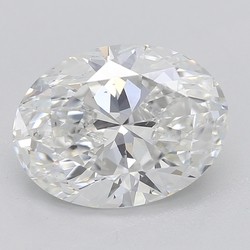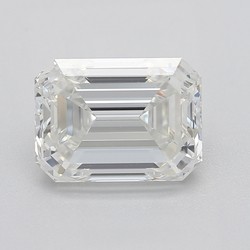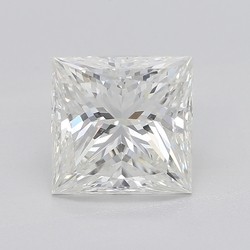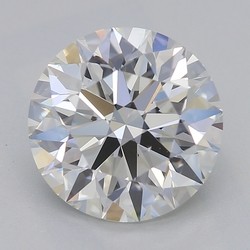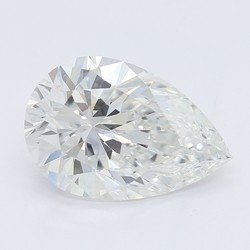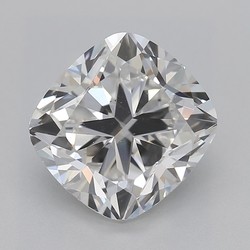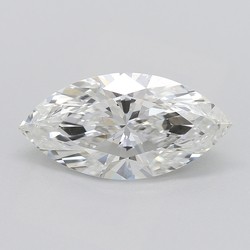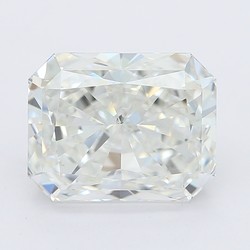The Insider’s Guide to Ring Resizing
Key Takeaways
- Getting a ring resized is usually possible, but it’s not quite as simple as some people make it sound.
- It’s always best to invest a little extra time and effort into determining the correct ring size for your partner before ordering the ring, than to hope for the best and trust that you’ll be able to get the size adjusted if you’re not right.
- Some features, like pavé or channel set stones, make it very difficult for jewelers to adjust the ring’s size.
- Reducing the ring’s size is easier (and, often, cheaper) than making it bigger.
- A jeweler can usually only adjust the ring by a couple of sizes. More dramatic changes might require a new ring to be created, and the original stones re-set within it.
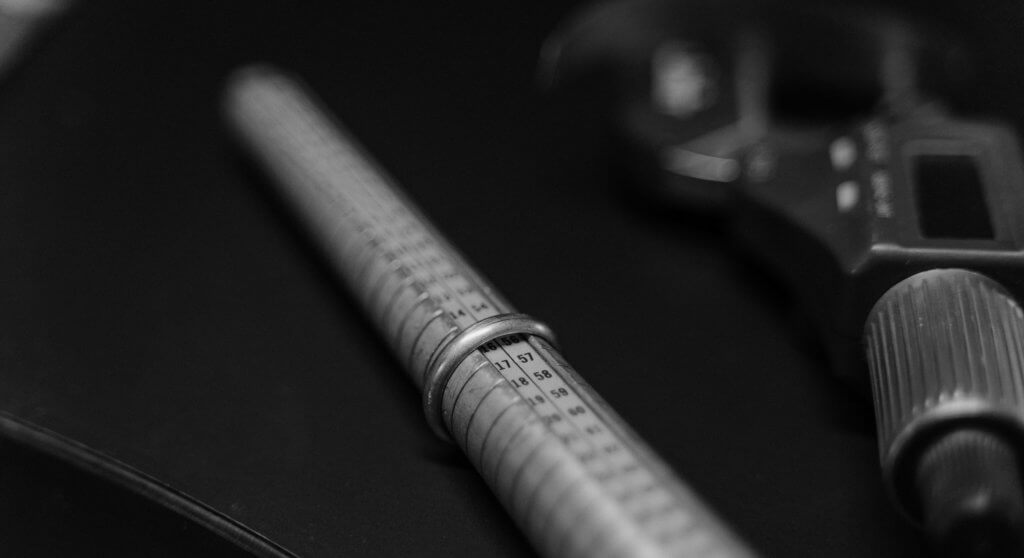
It’s easy to get caught up on planning the words you’re going to say, making sure the photographer understands their cue, and maybe even practicing how you’re going to go down on one knee.
But there’s one thing a lot of us tend to gloss over – that is, until the moment finally arrives: actually getting the ring onto her finger for the first time.
Like many aspects concerning an engagement, something that sounds so simple is actually pretty fraught with hazards. The wrong size of ring could fail to make it past her cuticle, or it could slide straight back off before you even make it back up onto two feet again. This is why it’s vital that any shopper takes the time to read up on how to choose a ring size before they go too far.
Nevertheless, it pays to understand the basics of getting a ring resized. Whether you were a little off to begin with, or your partner’s ring size has changed over the years, here’s what you need to know.
- The Basics
- Does Resizing a Ring Damage it?
- How Do They Resize Rings Smaller?
- Do You Lose Gold When You Resize a Ring?
- How Do They Resize Rings Bigger?
- How Many Times Can a Ring be Resized?
- Difficulties
- Time and Cost
- When to Resize
- Our Summary
The Basics
While it may seem self-explanatory, there are a few things you might not realise about ring resizing that you’ll want to know before you jump to any conclusions.
Does Resizing a Ring Damage it?
While some techniques can undermine the strength and appearance of your ring, revisiting your trusted local jeweler will offer much more security against those unwanted eventualities.
While some online-only vendors offer to resize your rings via mail, it is understandably daunting for anyone to entrust their engagement ring or wedding band to shipping services.
Talking to your jeweler face to face, and having them double- and triple-check the ring size you need, will make sure that the process preserves the beauty and strength of your ring, and that you don’t need to return a few weeks down the line because the ring still doesn’t fit right.
How Do They Resize Rings Smaller?
Jewelers make rings smaller by removing a small section of the band, then pushing it back together and soldering the gap closed.
For diamond rings, the jeweler will typically immerse the diamond in cool water while he solders the band, to ensure the stone doesn’t suffer any damage from the intense heat needed to fuse the metal together.
The process becomes significantly more complicated if the shank (band) of the ring is not a single, solid piece of metal. For instance, reducing the size of a tension set ring is virtually as complicated as making it from scratch, since the entire ring relies on its own shape and structure to hold the diamond in place.
Similarly, pavé or channel settings can make resizing a lot more complicated. Some diamonds may have to be removed, which could throw off the balance and symmetry of the shank. Of course, a skilled jeweler is more than capable of ensuring a beautiful final result, but the process may be a lot more time consuming and costly than it would be for a plain band.
Do You Lose Gold When You Resize a Ring?
Yes, the jeweler uses excess gold in other rings, but this will be factored into the cost of resizing your ring.
Even the smallest piece of gold can be put to good use, and no reputable jeweler will want to waste it. They can use those tiny ‘offcuts’ to increase the size of other rings, or to make a repair.
The amount you lose will, in all likelihood, be very minor, but your jeweler will take any amount of gold they gain from your ring into account when they create a price for resizing it, so don’t let this deter you.
How Do They Resize Rings Bigger?
While it is possible for a jeweler to stretch the band of a ring, many of them prefer to add in a small amount of metal to create a larger band, without risking its strength or durability.
As you can imagine, stretching a piece of metal can lead to it being thinner and frailer than it was before. This process is safe for thicker, solid wedding bands that only require a slight resize, but bands that are already thin can become significantly weaker if they are stretched too much.
Also, in the case of engagement rings, stretching the shank can put the diamond and center setting at risk, so it’s rarely used in these instances.
As with shrinking a ring, certain settings and features like pavé and tension can make it much more difficult for jewelers to alter the size, and could take longer than the average resizing process as a result.
How Many Times Can a Ring be Resized?
Most ring designs are capable of undergoing a couple of resizes in their lifetime, although some are much more fragile than others, and shouldn’t be resized unless absolutely necessary.
Could you get away with resizing a plain wedding band or simple diamond solitaire three times over the course of your life? Possibly – although you jeweler can offer the best insight into this.
For the most part, however, it’s best to approach resizing as a last-resort option. Temporary changes in finger size – for instance, if your partner is pregnant – probably shouldn’t prompt you to go to your jeweler once again and as for a slight change to be made, since each session will risk undermining the strength of the metal (and the design), even with the best jeweler working on it.
Difficulties
Resizing may sound relatively simple in practice but, when it gets down to it, it’s a complex process that requires the jeweler to overcome the strength and rigidity of metal – all while protecting your valuable diamond at the center of it all.
What Rings Cannot be Resized?
Generally, the only rings that cannot be resized are those that are not made from metal – for instance, rings made of quartz or wood. Still, some jewelers may not have the experience to resize metal rings featuring highly complex designs.
Experienced jewelers will be able to use their skills to preserve the original design of the ring as much as possible. Complex filigree, for instance, will need to be reworked when any adjustment is made to the size of the band – and, as we mentioned above, the same goes for pavé settings and eternity bands.
In fact, some eternity bands won’t be resizable, and you might have to think instead about having the diamonds reset within a larger or smaller band. The story could be the same for a tension engagement ring, too, since the original design depends so much on its own specific shape and size.
If you’re still nailing down the specifics of your ring design, your jeweler will bring this side of things up at some point during your consultation – the importance of sizing your partner’s finger right the first time, rather than after the fact. If your design is particularly tricky to resize, then your jeweler will probably urge you to make doubly sure that you’ve got the size exactly as it should be.
Can You Resize a Ring by Any Size?
No, there are limits on how much a ring can be resized by – usually no more than two US sizes.
If your fiancée is a US ring size 5, and you (somehow) got it wrong enough to buy a US ring size 9, for instance, then there’s a very strong chance that your jeweler won’t be able to resize it to fit her finger. Altering the band by that many sizes could easily ruin the ring, and put the diamond at risk, so your jeweler would likely recommend that you have an entirely new ring cast – and the diamond transferred into it.
In general, a ring has to be relatively close to fitting your fiancée’s finger for it to be considered possible for a jeweler to make it fit.
Does Resizing a Ring Make Diamonds Fall Out?
It’s a distinct possibility, and a particular risk for rings that have accent stones along the shank. A simple resize may not even be possible in these situations.
For the most part, however, jewelers are more than capable of protecting a center diamond while they work. For some rings, the diamond might have to be removed and set aside during certain stages of the process; in others, it can remain in its setting without any risk.
The key consideration here is the fact that a reputable jeweler will not take any risks with your diamond. While incredibly hard, diamond can be chipped or scratched – particularly when the jeweler is required to exert some significant force on the ring – so any worst case scenarios will be protected against.
Can You Take Diamonds Out of a Ring and Make a New One?
Yes, and some people choose to do this as a way of incorporating a family ring into a new and more wearable design. It’s also something your jeweler might recommend if your ring is way too big or small for your partner to wear.
This is a pretty major step up from a simple resize, but, if your ring is far too complex to be adjusted – and particularly if your ring is several sizes out – it may be your only option. A good jeweler will, of course, do everything they can to avoid that – but not if it puts your diamonds, or any other gemstones, at risk in the process.
Can Platinum Rings be Resized Smaller?
Yes, but it’s a much more intensive process than resizing gold.
Platinum is a pretty unique metal, and one of its most challenging features is the fact that it requires very high temperatures before it can be altered – but, once those high temperatures are reached, it heats up very quickly. This can mean that any diamonds set within the metal are exposed to a rapid change in temperature, unless they are carefully removed from the band or, if possible, kept cool throughout the process.
Platinum’s ability to transfer heat rapidly also means that it can develop little air holes along the surface – something no one wants to find on their important jewelry.
Of course, skilled jewelers are trained to work with platinum, rather than against it, but there’s no denying the fact that, compared with other precious metals like gold, it’s a lot trickier to work with. You can expect a platinum ring to take longer to be resized than a gold ring, and for it to cost more.
Speaking of…
Time and Cost
Nobody wants to have to part with their ring, whether the proposal happened two days ago or twenty years ago. Being able to wear your ring without worry, however, is certainly worth the time and money it takes to get there – just make sure you’re prepared beforehand.
Can a Ring be Resized the Same Day?
Some resizes will take minutes, while others will take days or even a couple weeks to complete. It all depends on the metal used, the complexity of the design, and the number of sizes your ring needs to go up or down.
In general, taking your ring into a local jewelry store – ideally to the same jeweler who designed and created your ring in the first place – will prove far quicker than sending it off to one of the large chains or online vendors. Why? Because your local jeweler will have fewer orders to get through, and won’t be left waiting on the mailman before they can get to work.
The other benefit to this is that they can make sure the size you’re asking the ring to be resized to is the right size for you. Sure, you can measure your finger from home, but one small mistake could mean that the ring has to undergo yet another session on the jeweler’s workbench.
Is it Cheaper to Size a Ring Up or Down?
Sizing down a ring will cost less, since the process does not require you to pay for any additional metal.
Sure, the amount of extra gold or platinum needed to make a ring one or two sizes bigger – a difference of less than a millimeter, in many cases – may sound like a negligible amount but, when it comes to precious metals, every single bit is accounted for.
As we mentioned earlier on in this article, jewelers will offset the cost of resizing your ring against any metal they salvage from the ring, which can be melted down or used for soldering other pieces. This won’t be anywhere near enough to cancel out the cost of resizing, so don’t expect the process to be free, but it will lower the cost slightly.
On the flipside, those looking to size up are likely to be the ones making use of those tiny offcuts, which can be used to fill in the gaps of a band that has been widened. So, in addition to the jeweler’s time, you also need to pay for those additional materials required. Again, a pretty minor cost – particularly compared with what you paid for the ring in the first place – but enough to make a difference between the two.
How Does it Cost to Get a Ring Resized?
It depends on the store, and whether or not you bought it from that jeweler in the first place, but you can expect to pay around $40 – $50 for a standalone service, or significantly more if the ring is highly complex.
Your first port of call should always be the jeweler you bought the ring from in the first place. Sometimes, the resize will be offered free within the first few weeks or months of purchase but, even not, their expertise will prove most valuable to your ring – and that is, of course, what matters far more than anything else.
Nevertheless, you don’t want to get ripped off. A simple resize shouldn’t cost the earth, and generally won’t be any higher than around $60. If your ring features a lot of intricate detailing or accent stones, however, then you’ll have to put yourself at the mercy of the experts – another compelling reason to start off on the right foot, and pick a jeweler with a strong reputation in your local community.
We’ve already mentioned a couple reasons why the online vendors aren’t a great idea, but we realize it’s a convenient option. Their free resizing services are often only available when you bought the ring from them in the first place, however, so we’d advise against this route.
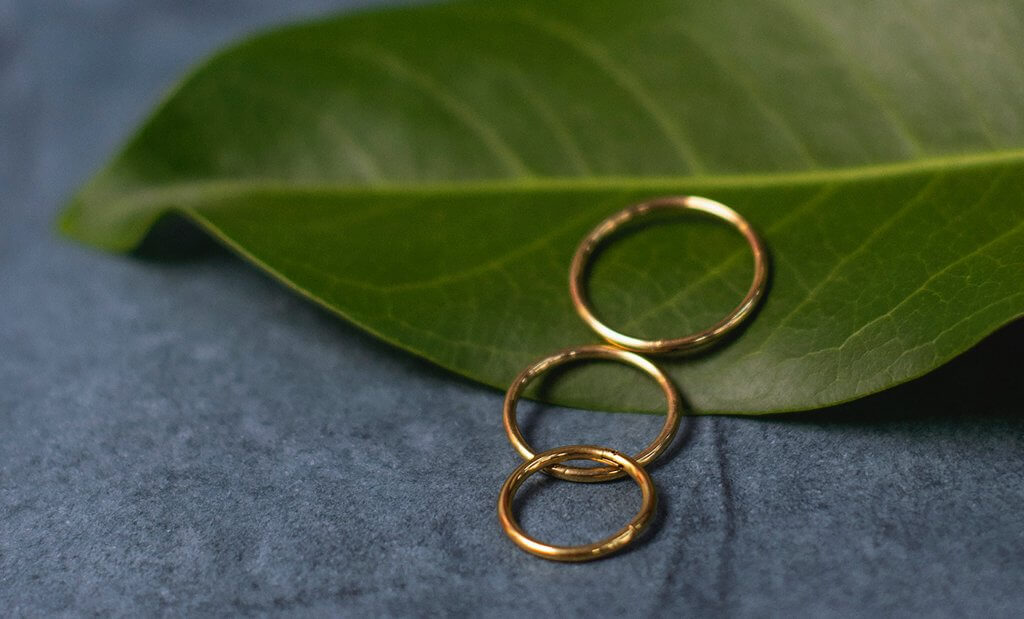
When to Resize
If you’re not used to wearing rings, then knowing when to get it resized isn’t always something that comes naturally.
How do I Know if My Ring Fits Properly?
It should move over the finger knuckle with a little resistance, or it could wind up falling off easily. It should hug the base of the finger a way that feels natural, without any need for forcing or ‘screwing’ the ring into place. Conversely, it shouldn’t slide about on the finger – or turn itself upside down.
This is something many women wearing the wrong size engagement ring encounter – the annoyance of that beautiful diamond, intended to hold pride of place at the apex of her finger, sliding around so that falls to face the inside of her hand.
Not only is it uncomfortable, and frustrating trying to keep it in place all day, but it also puts the diamond at risk of getting scratched, scraped, or knocked as you try to go about your day normally.
If it’s twisting, you may want to think about going down half a size.
A ring that’s too tight will prove annoying in a totally different way. For one thing, it can ruin the romance of a good proposal; for another, if you do manage to get it on, you might worry that you won’t be able to get it back off again, and that you might need to cut it off.
A ring shouldn’t pinch the fleshy part of your finger – or, worse still, prove so tight that the skin around it starts to turn red.
Both scenarios are examples of times when, despite the best efforts, a resize is needed.
Is Ring Resizing Worth it?
Yes. An ill-fitting ring is not only uncomfortable and annoying, but it’s also a pretty major risk.
For anyone, getting used to going about everyday life with a diamond worth thousands of dollars perched on their finger isn’t easy. True, engagement rings are designed to be a lot stronger than they look, and those four to six prongs are more than capable of holding a diamond in place for decades (with proper checks from a jeweler every once in a while), but that doesn’t make those first few weeks any easier.
The biggest risk to your diamond comes when you can’t keep the ring in one place. Imagine the heart-stopping moment you look down after a session at the gym, an hour in the grocery store, or a day at work to find that your ring has simply vanished.
Sure, it’s an errand you’d probably rather not have to make, but the alternative is far worse.
Our Summary: Does Resizing a Ring Ruin it?
In the majority of cases, no, resizing a ring is a quick and simple process that helps plenty of people enjoy wearing their rings, rather than struggling to keep them on. Still, some rings cannot be resized.
With a good, experienced jeweler, resizing a ring will never ruin it, since they will be sure to let you know if the design of your ring makes a resize impossible.
In that case, provided your jeweler is confident that they will be able to adjust your ring’s shank without interfering with its design or, most important of all, damaging any diamonds it holds, then you needn’t lose sleep over the idea that it will be returned to you bent out of shape, broken, or missing any stones.
At WillYou.Net, our rigorous screening process means that we only recommend reputable local jewelers to our readers, meaning you can put your faith in their skills from your initial consultation, through the process of buying an engagement ring, picking out your wedding bands – and forever after that.
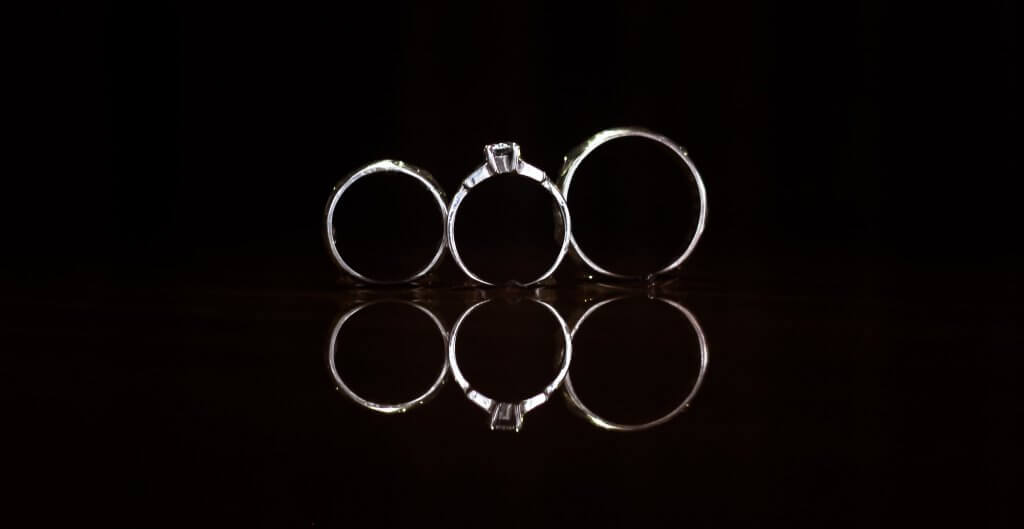
Dec 24, 2021 By Willyou.net
Ring Size Secrets: How to Choose the Perfect Fit
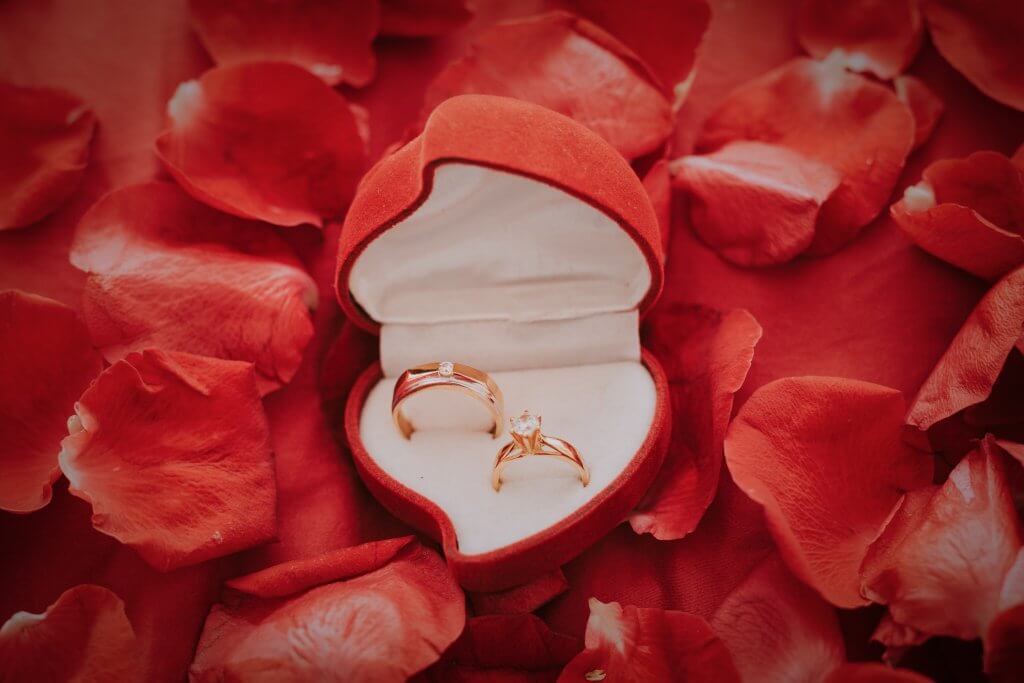
Dec 24, 2021 By Willyou.net
The Average Diamond Engagement Ring Size: Understanding the Standard
